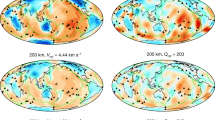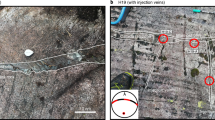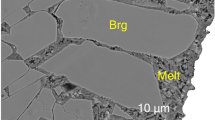Abstract
The boundary between Earth’s rigid lithosphere and the underlying, ductile asthenosphere is marked by a distinct seismic discontinuity1. A decrease in seismic-wave velocity and increase in attenuation at this boundary is thought to be caused by partial melt2. The density and viscosity of basaltic magma, linked to the atomic structure3,4, control the process of melt separation from the surrounding mantle rocks5,6,7,8,9. Here we use high-pressure and high-temperature experiments and in situ X-ray analysis to assess the properties of basaltic magmas under pressures of up to 5.5 GPa. We find that the magmas rapidly become denser with increasing pressure and show a viscosity minimum near 4 GPa. Magma mobility—the ratio of the melt–solid density contrast to the magma viscosity—exhibits a peak at pressures corresponding to depths of 120–150 km, within the asthenosphere, up to an order of magnitude greater than pressures corresponding to the deeper mantle and shallower lithosphere. Melts are therefore expected to rapidly migrate out of the asthenosphere. The diminishing mobility of magma in Earth’s asthenosphere as the melts ascend could lead to excessive melt accumulation at depths of 80–100 km, at the lithosphere–asthenosphere boundary. We conclude that the observed seismic discontinuity at the lithosphere–asthenosphere boundary records this accumulation of melt.
This is a preview of subscription content, access via your institution
Access options
Subscribe to this journal
Receive 12 print issues and online access
$259.00 per year
only $21.58 per issue
Buy this article
- Purchase on Springer Link
- Instant access to full article PDF
Prices may be subject to local taxes which are calculated during checkout



Similar content being viewed by others
References
Gutenberg, B. Untersuchungen zur Frage, bis zu welcher Tiefe die Erde kristallin ist. Z. Geophys. 2, 24–29 (1926).
Schmerr, N. The gutenberg discontinuity: melt at the lithosphere–asthenosphere boundary. Science 335, 1480–1483 (2012).
Allwardt, J. R. et al. Effect of structural transitions on properties of high–pressure silicate melts: 27Al NMR, glass densities, and melt viscosities. Am. Mineral. 92, 1093–1104 (2007).
Waseda, Y. & Toguri, J. M. in Dynamic Process of Material Transport and Transformation in the Earth’s Interior (ed. Marumo, F.) 37–51 (Terra Sci., 1990).
Agee, C. B. Crystal–liquid density inversions in terrestrial and lunar magmas. Phys. Earth Planet. Inter. 107, 63–74 (1998).
Ohtani, E. & Maeda, M. Density of basaltic melt at high pressure and stability of the melt at the base of the lower mantle. Earth Planet. Sci. Lett. 193, 69–75 (2001).
Suzuki, A., Ohtani, E., Terasaki, H. & Funakoshi, K. Viscosity of silicate melts in CaMgSi2O6–NaAlSi2O6 system at high pressure. Phys. Chem. Miner. 32, 140–145 (2005).
Bottinga, Y. & Weill, D. F. The viscosity of magmatic silicate liquids: A model for calculation. Am. J. Sci. 272, 438–475 (1972).
Fujii, T. & Kushiro, I. Yearbook Vol. 76, 461–465 (Carnegie Inst., 1977).
Hirschmann, M. M. Partial melt in the oceanic low velocity zone. Phys. Earth Planet. Inter. 179, 60–71 (2010).
Bottinga, Y. & Allègre, C. J. Partial melting under spreading ridges. Phil. Trans. R. Soc. Lond. A 288, 501–524 (1978).
Sakamaki, T. et al. Measurement of hydrous peridotite magma density at high pressure using the X-ray absorption method. Earth Planet. Sci. Lett. 287, 293–297 (2009).
Sakamaki, T. et al. Density of carbonated peridotite magma at high pressure using an X-ray absorption method. Am. Mineral. 96, 553–557 (2011).
Lange, R. A. & Carmichael, I. S. E. Densities of Na2O–K2O–CaO–MgO–FeO–Fe2O3–Al2O3–TiO2–SiO2 liquids: New measurements and derived partial molar properties. Geochim. Cosmochim. Acta 51, 2931–2946 (1987).
Funamori, N., Yamamoto, S., Yagi, T. & Kikegawa, T. Exploratory studies of silicate melt structure at high pressures and temperatures by in situ X-ray diffraction. J. Geophys. Res. 109, 1–8 (2004).
Okuno, M. & Marumo, F. The structures of anorthite and albite melts. Mineral. J. 11, 180–196 (1982).
Meade, C., Hemley, R. J. & Mao, H. K. High–pressure X-ray diffraction of SiO2 glass. Phys. Rev. Lett. 69, 1387–1390 (1992).
Brearley, M. & Montana, A. The effect of CO2 on the viscosity of silicate liquids at high pressure. Geochim. Cosmochim. Acta 53, 2609–2616 (1989).
Sobolev, A. V. & Chaussidon, M. H2O concentration in primary melts from supra-subduction zones and mid-ocean ridges: Implications for H2O storage and recycling in the mantle. Earth Planet. Sci. Lett. 137, 45–55 (1996).
Dixon, J. E. & Clague, D. A. Volatiles in basaltic glasses from loihi seamount, Hawaii: Evidence for a relatively dry plume component. J. Petrol. 42, 627–654 (2001).
Whittington, A., Richet, P. & Holtz, F. Water and the viscosity of depolymerized aluminosilicate melts. Geochim. Cosmochim. Acta 64, 3725–3736 (2000).
Connolly, J. A. D., Schmidt, M. W., Solferino, G. & Bagdassarov, N. Permeability of asthenospheric mantle and melt extraction rates at mid-Ocean ridges. Nature 462, 209–212 (2009).
Circone, S. & Agee, C. B. Compressibility of molten high-Ti mare glass: Evidence for crystal-liquid density inversions in the lunar mantle. Geochim. Cosmochim. Acta 60, 2709–2720 (1996).
Spiegelman, M. Physics of melt extraction: Theory, implications and applications. Phil. Trans. R. Soc. Lond. A 342, 23–41 (1993).
Naif, S., Key, K., Constable, S. & Evans, R. L. Melt-rich channel observed at the lithosphere–asthenosphere boundary. Nature 495, 356–359 (2013).
Zimmerman, M. E., Zhang, S., Kohlstedt, D. L. & Karato, S. Melt distribution in mantle rocks deformed in shear. Geophys. Res. Lett. 26, 1505–1508 (1999).
Bruhn, D., Groebner, N. & Kohlstedt, D. L. An interconnected network of core–forming melts produced by shear deformation. Nature 403, 883–886 (2000).
Hier–Majumder, S. Development of anisotropic mobility during two–phase flow. Geophys. J. Int. 186, 59–68 (2011).
Karato, S. On the origin of the asthenosphere. Earth Planet. Sci. Lett. 321–322, 95–103 (2012).
Lewis, J., Schwarzenbach, D. & Flack, H. D. Electric field gradients and charge density in corundum, α–Al2O3 . Acta Crystallogr A 38, 733–739 (1982).
Acknowledgements
This work was supported by Grant-in-Aid awards for Scientific Research to E.O. (numbers 16340164, 18104009 and 22000002) and S.U. (numbers 13440163, 16340170 and 20103003) from the Ministry of Education, Culture, Sports, Science, and Technology of the Japanese Government. This work was also partially supported by the Global Center of Excellence program of Earth and Planetary Science, Tohoku University, Japan. T.S. was supported by a Research Fellowship of the Japan Society for the Promotion of Science for Young Scientists. The synchrotron radiation experiments were performed at SPring-8 with the approval of the Japan Synchrotron Radiation Research Institute (Proposal No. 2004A0250, 2004B0049, 2005A0453, 2005B0011, 2006A3705, 2006B3710, 2002B0087, 2003A0057, 2003B0036, 2004A0384, 2004B0646, 2007A1095 and 2009A1661) and Japan Atomic Energy Agency (Proposal No. 2002-S-01, 2003-S-05, 2004-S-04, 2006A-E17 and 2006B-E23). Y.W. acknowledges support from the NSF (EAR 0711057). All authors acknowledge useful discussions with and suggestions by S. Labrosse.
Author information
Authors and Affiliations
Contributions
T.S., S.U., A.S., E.O. and Y.K. performed the density measurements. A.S., H.T., E.O., T.S. and K-i.F. carried out the viscosity measurements. T.S., A.S., H.T., E.O. and K-i.F. performed the structure measurements. T.S., E.O., A.S., Y.W. M.D.B. and J.W.H. made arguments on geological applications of the experimental results, and prepared the paper. All authors discussed the results and commented on the manuscript.
Corresponding author
Ethics declarations
Competing interests
The authors declare no competing financial interests.
Supplementary information
Supplementary Information
Supplementary Information (PDF 754 kb)
Rights and permissions
About this article
Cite this article
Sakamaki, T., Suzuki, A., Ohtani, E. et al. Ponded melt at the boundary between the lithosphere and asthenosphere. Nature Geosci 6, 1041–1044 (2013). https://doi.org/10.1038/ngeo1982
Received:
Accepted:
Published:
Issue Date:
DOI: https://doi.org/10.1038/ngeo1982
This article is cited by
-
Insights into magma ocean dynamics from the transport properties of basaltic melt
Nature Communications (2022)
-
Experimental measurements of the viscosity and melt structure of alkali basalts at high pressure and temperature
Scientific Reports (2022)
-
Stress-induced amorphization triggers deformation in the lithospheric mantle
Nature (2021)
-
A comparative study on pressure-induced structural transformations in a basaltic glass and melt from Ab initio molecular dynamics calculations
Physics and Chemistry of Minerals (2021)
-
Structural dynamics of basaltic melt at mantle conditions with implications for magma oceans and superplumes
Nature Communications (2020)



